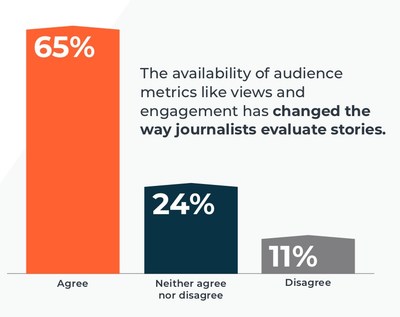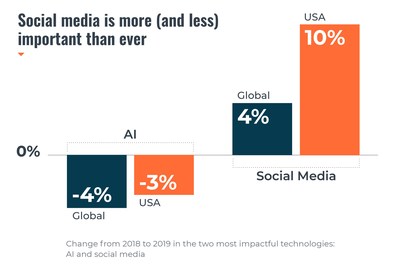To uncover the latest trends and biggest challenges facing the media industry, Cision released its 2019 State of the Media Report, the company’s tenth annual State of the Media.
This year’s report was Cision’s largest ever, surveying nearly 2,000 journalists from 10 countries around the world, to learn about the main issues facing the global media industry in 2019, and how PR and communications professionals can better work with their journalist counterparts.
Despite an increasing number of challenges facing journalists– from fake news and misinformation campaigns, to shrinking budgets and newsrooms, to changes in social media algorithms– the report reveals several optimistic findings. For the second year in a row, respondents reported a decrease in the public’s distrust of the media; 63% of respondents felt the public lost trust this year, which is down from 71% in 2018 and 91% in 2017.
Marketing Technology News: Grant Thornton’s Tax practice embraces Microsoft Power BI
“While fake news is still a concern, it’s not journalism’s top challenge this year. Unfortunately issues around social media and resources lead the list of concerns, especially in the United States, Canada and United Kingdom,” said Kevin Akeroyd, Cision CEO. “But the news isn’t all bad; we are encouraged to see a continued decrease in perceptions of public distrust in the media. Trust is the major theme in this year’s survey results; in fact, it seems tied to the future of the industry in many ways. Telling a reliable, informative and relevant story is more important than ever, and journalists are using audience data to better understand what stories generate the traffic and revenue journalists need to thrive in today’s media environment.”
Marketing Technology News: MGH Survey Finds Nearly Half of US Diners Have Tried a New Restaurant Because of its Social Media Posts
Survey responses also reflect growing concerns around the changing role of social media, an increasing reliance on data-driven storytelling, and the relationship between media and communications professionals.

Other key takeaways from the report include:
- Journalists continue to rely more and more on data to make decisions about the stories they focus on. 65% of journalists globally feel that detailed audience metrics like views and engagement have changed the kinds of content they publish. 43% of respondents focus primarily on readership or views, 20% focus on engagement, and 15% focus on impact on revenue.
- PR and communications professionals are valuable partners to journalists, especially in this turbulent media environment. However, 75% of journalists said that fewer than 25% of the pitches they receive are relevant. Journalists reported that the single most effective thing PR professionals can do to improve their relationship with the media is to better understand the end customer and provide information more relevant and customized to that audience.
- Social media is both less- and more- important than ever. Because of the volatile nature of social media in 2018, journalists have increasingly complex feelings about the importance of social media. 38% of journalists surveyed agree that updated social media algorithms- such as changes to the Facebook News Feed- will be the most important technology to impact their work in 2019, which is an increase in the past year. That impact is not always positive, as journalists have concerns about relying on social media for publishing content.

Marketing Technology News: Philo Reveals Connected TV Ad Platform to Reach Latest Generation of TV Lovers












Comments are closed.